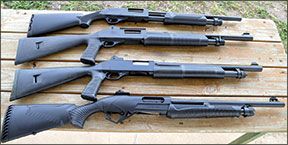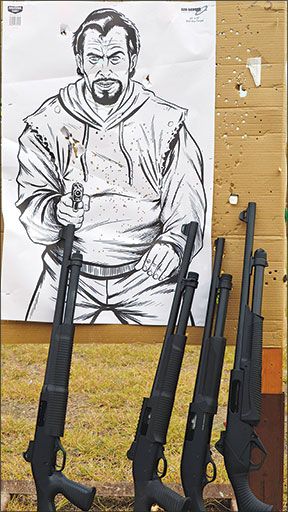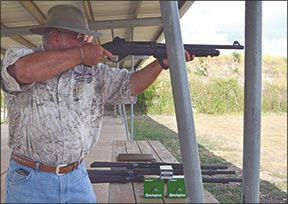Unlike the conflicts with bad guys depicted on television and in the movies, a home owner in a self-defense situation will rarely fire more than one or two shots. In most cases, the owner of a firearm specifically designed to stop the threat of an intruder will never fire even one shot in their home because they will never be put in such a position.

With the caveat that there might be a slight possibility of a zombie apocalypse or another type of breakdown of society, most self-defense shotgun owners are simply looking for a little peace of mind and a lot of confidence that their firearm will perform in a capable manner when and if it is required.
Nevertheless, it is also a fact that self-defense shotguns have been and continue to be a very popular item in the firearms market. Models from basic slide-actions that have been slightly modified from their field version counterparts to highly adapted tools designed to meet the extreme needs of law enforcement and military users are among the available offerings.
At a reader’s request, we selected several new models of self-defense shotguns that carry low to moderate price tags and pitted them against one of the popular veteran self-defense shotguns to see how they would perform. The 12-gauge pumpguns in our test included the Benelli Super Nova Tactical No. 29155 pump-action 12 Gauge, $559, which has been a self-defense staple for years, and the recently introduced Stevens Model 320 Home Defense No. 19495, $270; the CZ Model 612 Home Defense No. 06520, $290; and the CZ Model 612 HC-P No. 06510, $349.
All of the short-barreled pump-action shotguns are designed for a specific need and purpose — self defense — and do not easily lend themselves to other uses, such as hunting in the field or busting clay targets.
As one veteran gunsmith in our group noted: “Most of these shotguns will not have a box of shells fired through them in a year and a lot won’t have more than a half-dozen boxes shot in them during a lifetime.”
With this truism in mind, we limited our field testing of the four shotguns to firing at paper targets on the range and did not attempt any evaluation of how the shotguns would handle clay targets or birds in the air. These self-defense firearms are designed to be fired more like a rifle than a scattergun, so it would be unfair to judge them on the qualities found in high-dollar, better-balanced firearms that have a place in the field and on clay-target ranges.
Sticking with the types of ammunition that would handle most self-defense situations, we put the four shotguns through patterning and performance tests with a variety of shotgun shells. The ammo selection in our shooting bag included Remington ShurShot Heavy Dove 2.75-inch loads packing 1.125 ounces of No. 6 shot with an average muzzle velocity of 1,255 fps; Federal Power-Shok 2.75-inch loads with 27 pellets of No. 4 buckshot and an average muzzle velocity of 1,325 fps; and Winchester Super-X 2.75-inch 1-ounce rifled hollowpoint slugs with an average muzzle velocity of 1,600 fps.
When putting patterns on paper, we utilized the recently introduced Birchwood Casey Eze-Scorer 12×18-inch Transtar Blue and BC27 Green Silhouette Targets and the 23×35-inch Bad Guy, all on non-reactive paper. The targets, set at ranges of no more than 20 feet (typical of a home-defense situation), allowed us to realistically and effectively evaluate the performance of the test shotguns. We fired the Federal Power-Shot No. 4 buckshot at two targets, first at the Birchwood Casey Bad Guy set downrange at 20 feet and then at the Birchwood Casey Transtar Blue or BC27 Green Silhouettes about 10 feet to the side of the Bad Guy. The Remington ShurShot No. 6 shot was fired at the chest and head area of the Bad Guy targets, followed by a Winchester Super-X slug as a head shot.
It should be noted that all of the ammunition fired in the short-barreled shotguns produced quite a punch on both ends. These are not the type of firearms designed for extensive time on the firing range unless the shooter is immune from recoil. For the sake of our shoulders, a few rounds fired with each variety of ammunition were all that we deemed necessary for our evaluation. Here are the test results:
Benelli Super Nova Tactical No. 29155 Pump-Action12 Gauge, $559
A stalwart of self-defense shotguns, this was the model selected as the measuring tape for the less expensive versions that have recently hit the market. The heft and balance of the shotgun that sports an 18.5-inch barrel topped with an adjustable Ghost Ring sight was solid and comfortable. The Benelli was the heaviest of the test shotguns, weighing 7 pounds unloaded, and we particularly liked the feel of the grooved polymer forearm and pistol grip. The shotgun was very easy to control during rapid-fire testing.
Our test shotgun featured the optional three-dot tritium inserts for the Ghost Ring sights, and we found we could easily align the three dots for accurate placement of slugs on the paper targets. A magazine cut-off button on the underside of the forearm — a feature unique to Benelli — allowed for the chamber to be emptied without feeding another round from the magazine. That was another nice touch in a quality self-defense tool.
We did have a little concern about the amount of trigger pressure required to touch off a shot. Although a little gunsmith work would correct the problem, the out-of-the-box trigger pull of 8.75 pounds was too hefty for our tastes.

Patterning performance on the paper targets was about the same as the other shotguns. The average number of buckshot hits on the Bad Guy target was 23 and the smaller target average was 19. Slugs fired from 20 feet downrange always struck the head of the target, and a solid pattern of No. 6 pellets in the chest of the target was the result of every round of bird shot. When cycling the rounds through the Benelli, we found that the shotgun functioned without a flaw even when different types of shells were fed into the magazine. We considered this a big plus in the dependability ranking.
Our Team Said: The Benelli lived up to its reputation and set a standard that allowed us to properly evaluate the test shotguns that carry a lower price tag. Those who don’t mind paying a little more for their peace of mind would not be disappointed with the Super Nova.
Stevens Model 320 Home Defense No. 19495Pump-Action 12 Gauge, $270
The fact that this was the bottom dollar model in our test group was quickly reduced in significance when we took the shotgun out on the range. Sporting the same length barrel (18.5 inches) and Ghost Ring sights of both the Benelli and CZ 612 HC-P, we were pleased to find the visibility of the chartreuse light-bar front sight through the Ghost Ring was exceptional. Getting on target and staying on target was quicker and easier with the Stevens than with any of the other test firearms, our testers said.
This high visibility also transferred over to patterning performance, with the Stevens always placing 27 out of 27 buckshot pellets in the large target and producing an average of 25 hits in the smaller target. While this is not a huge variation — all of the shotguns produced very acceptable patterns in what would be considered kill zones — the Stevens did top the rankings of all four firearms.
Several slugs fired at the Bad Guy target from 20 feet hit right in the middle of the character’s forehead and the distribution of No. 6 pellets was quite solid in the target’s chest and head area. Although not as deeply etched into the synthetic material as the grooves in the Benelli, the forearm and full-length pistol grip of the Stevens were easy to hold and provided a steady shooting platform. Even in rapid-fire mode, the shotgun was easy and comfortable to put on target.
Patterned after the discontinued Winchester Model 1300, the appearance of the Stevens is very plain Jane. We were concerned about the effectiveness of the hollow synthetic stock, but found the recoil of the shotgun was no more shoulder shocking than with the other test firearms.
Trigger pull for the Stevens, breaking at 7 pounds, was considered a little excessive but became a non-factor after sending a few loads down range. As with the Benelli, a little gunsmith work to reduce the touch off to about 5 to 6 pounds would be recommended.
The only minor problem we encountered with the Stevens involved the action release located on the left rear of the trigger guard. The release button seemed to be a little small, although it could be worked by all of our test members. Each of the other firearms in the test had larger action release buttons in the front of the trigger guards. Since a person using one of these self-defense firearms in the home would rarely be wearing gloves, this was not considered a big issue.
Our Team Said: Several excellent features of this shotgun, including the very nice and highly visible sights; its patterning performance with all three types of ammunition; and the comfortable, solid feel of the firearm, impressed us.
CZ Model 612 Home Defense No. 06520Pump-Action 12 Gauge, $290
Tipping the scales at only 5.25 pounds, this was the lightweight model among our test shotguns and the shoulder shock from recoil was pretty much what we expected. Unless you are a 300-pound former football linebacker, expect a little punishment when touching off a shot with the 612.
This self-defense firearm could be transformed into a field shotgun with the simple replacement of its 18.5-inch barrel with a 26- to 30-inch version better suited for wingshooting. If being able to put the shotgun into double duty fits your needs, this is the model for you.
The black synthetic small forearm and slim pistol grip feature standard checkering that make the shotgun a little harder to control, particularly with heavy buckshot or slug loads. Holding the shotgun on target for second and third shots was just a little more difficult than with the other firearms, our shooters said.

During our patterning tests, we found the CZ placed an average of 20 buckshot pellets on the larger Bad Guy target and an average of 15 hits on the smaller blue and green targets. The performance with No. 6 shot was not as solid as with the other test models, and the slug shots to the head of the target were not as consistent as we would have liked. This may have been the result of the simple black ramped front sight, which was not as easy to place on the target as the sights of the other shotguns.
We encountered no functioning problems, other than several times when a little extra pressure on the forearm was required to cycle the third round. Not a major hiccup, but worth noting.
The trigger pull on the CZ was right at 6 pounds, which was the lightest of all the test models. The touch off point with a shotgun is not as important as the squeeze factor in a rifle, but as a general rule a lighter pull (5-6 pounds is a nice range) will improve accuracy even with a scattergun.
Our Team Said: For those who are comfortable with a self-defense firearm that is basically a short-barreled field gun, this model capably fulfills that requirement.
CZ Model 612 HC-P No. 06510 Pump-Action 12 Gauge, $349
A 20-inch barrel threaded for choke tubes made this shotgun stand out from the crowd. A little longer sighting plane and the ability to change chokes — the model is shipped with one cylinder choke — are two pretty good selling factors. Like the Stevens model, this CZ HC-P features the lightly grooved full length pistol grip and larger forearm instead of standard checkering. We encountered no problems with handling and maintaining good target holds when firing this shotgun at the targets.
Not quite as heavy as the Benelli, the CZ HC-P tips the scales at 6.5 pounds, but has the bulk and heft to help control shoulder shock from recoil. Even with the hollow stock like the other CZ home-defense model, the felt recoil was not unpleasant. Being able to maintain a better grip on the firearm with the larger forearm and full-length pistol grip were key recoil-reduction factors.
The Ghost Ring sights feature two red-fiber bars in the rear sight and a chartreuse bar in the front sight, but the colors did not stand out as well as those in the Stevens sights. We felt that our ability to accurately place shots on the targets was only slightly diminished by the visibility factor.
Reviewing the patterning performance with the CZ HC-P, we found a consistent average of 25 hits with the buckshot loads on both targets, and we could put the slugs right where we wanted them in the target’s face. The No. 6 shot pattern on the Bad Guy was solid and consistent at 20 feet. At that distance, there would be no appreciable difference if a tighter choke were installed in the barrel.
The CZ HC-P’s trigger pull was as excessive as it was with the Benelli, breaking at 8.75 pounds. We would recommend a trip to the gunsmith where the pull could be adjusted to a crisp 5-6 pounds to improve the shooting performance of this firearm.
For those who like to accessorize, the CZ HC-P also features a Picatinny Rail on top of the receiver that could hold a variety of optics. Allowing for the installation of a laser or red-dot scope above the Ghost Ring sight fits with the theme of the shotgun. The HC in its designation stands for “Horde Control,” as in stopping a zombie attack. It is just another feature designed to add some marketing pizzazz to a simple product.
Concerning the firearm’s performance on the range, we found that it cycled and handled as well as any of the other models in the test. Second and third shots were on target, and there were no hiccups when a variety of different loads were fired.
Our Team Said: As comfortable and easy to shoot and handle as any of the other models in the test, we found few faults in this relatively inexpensive self-defense firearm.
Written and photographed by Ralph Winingham, using evaluations from Gun Tests team testers.
































